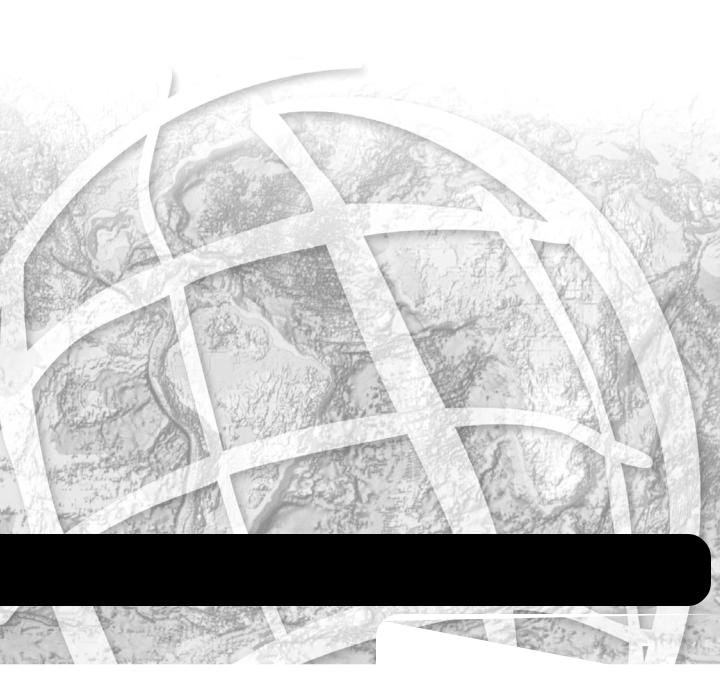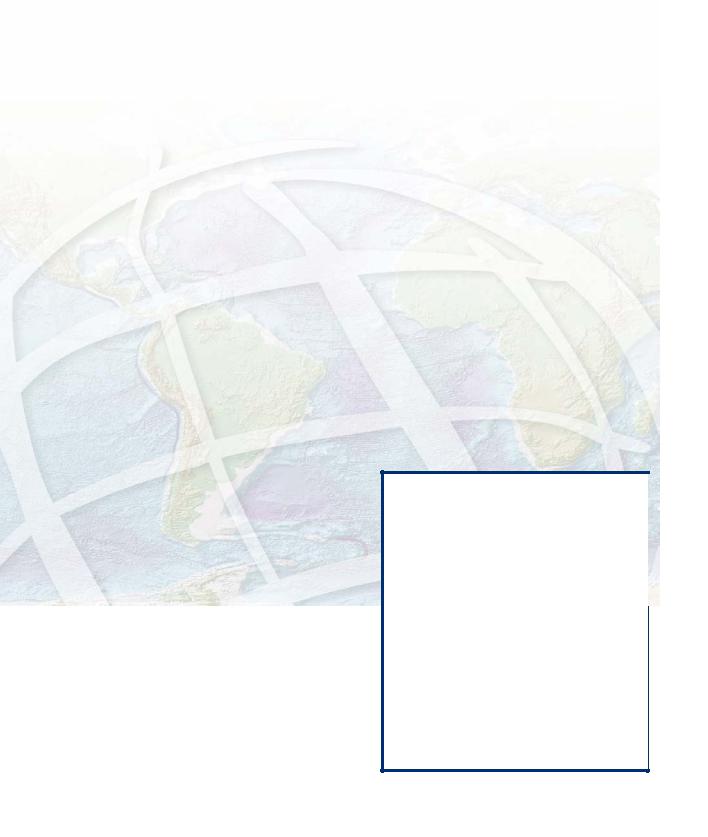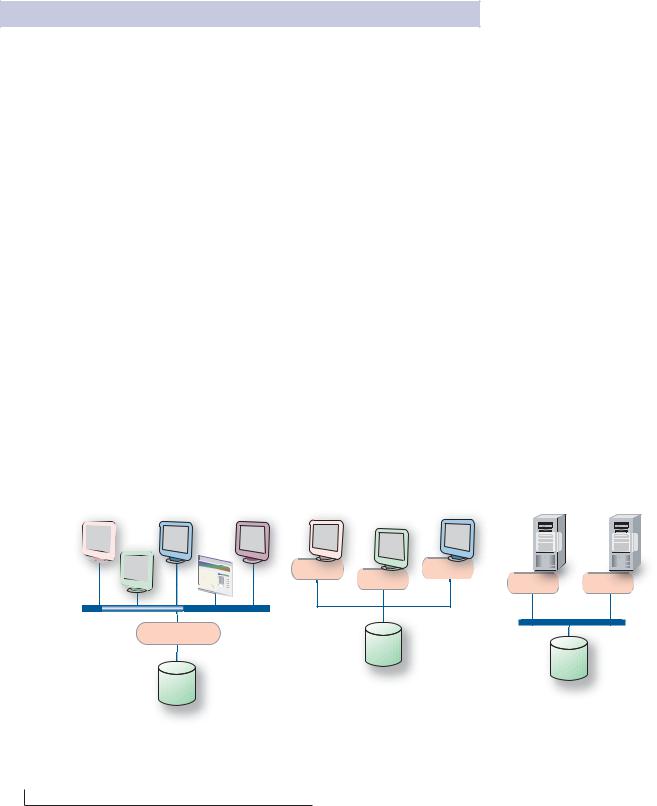
- •Contents
- •What is ArcSDE?
- •ArcSDE connection configuration options
- •ArcSDE for Developers
- •Organizing features
- •Types of features
- •Feature storage
- •Geometry storage options
- •Spatial indexing
- •Relational access and object relational access
- •Vector tables
- •Raster tables
- •The ArcGIS geodatabase
- •What is the geodatabase?
- •Geodatabase architecture
- •Accessing and using geodatabase application logic
- •Vector Data
- •Raster Data
- •Geodatabase storage in relational databases
- •Versioned geodatabases and distributed work flows
- •What is an application server?
- •Direct connections
- •Connecting with a direct connect driver
- •ArcSDE for Coverages
- •Administrators
- •Developers
- •End users
- •ArcSDE resources
- •Glossary

Understanding ArcSDE®
GIS by ESRI®
Copyright © 1999, 2001–2004 ESRI
All rights reserved.
Printed in the United States of America.
The information contained in this document is the exclusive property of ESRI. This work is protected under United States copyright law and other copyright treaties, and conventions. No part of this work may be reproduced or transmitted in any form or by any means, electronic or mechanical, including photocopying and recording, or by any information storage or retrieval system, except as expressly permitted in writing by ESRI. All requests should be sent to Attention: Contracts Manager, ESRI, 380 New York Street, Redlands, CA 92373-8100, USA.
The information contained in this document is subject to change without notice.
U.S. GOVERNMENT RESTRICTED/LIMITED RIGHTS
Any software, documentation, and/or data delivered hereunder is subject to the terms of the License Agreement. In no event shall the U.S. Government acquire greater than RESTRICTED/LIMITED RIGHTS. At a minimum, use, duplication, or disclosure by the U.S. Government is subject to restrictions as set forth in FAR §52.227-14 Alternates I, II, and III (JUN 1987); FAR §52.227-19 (JUN 1987) and/or FAR §12.211/12.212 (Commercial Technical Data/Computer Software); and DFARS §252.227-7015 (NOV 1995) (Technical Data) and/or DFARS §227.7202 (Computer Software), as applicable. Contractor/Manufacturer is ESRI, 380 New York Street, Redlands, CA 92373-8100, USA.
ESRI, SDE, ArcView, MapObjects, the ESRI globe logo, ArcInfo, ArcSDE, ArcCatalog, ArcGIS, ArcMap, ArcExplorer, ArcIMS, ArcObjects, Avenue, ArcStorm, Spatial Database Engine, ArcEditor, ArcPlot, ArcInfo LIBRARIAN, GIS by ESRI, the ArcExplorer logo, the ArcView logo, the ArcInfo logo, the ArcIMS logo, the ArcSDE CAD Client logo, the MapObjects logo, and www.esri.com are trademarks, registered trademarks, or service marks of ESRI in the United States, the European Community, or certain other jurisdictions.
Netscape and the Netscape N logo are registered trademarks of Netscape Communications Corporation in the United States and other countries. The Microsoft Internet Explorer logo is a trademark of Microsoft Corporation.
Other companies and products mentioned herein are trademarks or registered trademarks of their respective trademark owners.

Contents |
|
|
1 |
INTRODUCING ARCSDE ..................................................................................... |
1 |
What is ArcSDE? ............................................................................................................................. |
2 |
|
Why ArcSDE? ................................................................................................................................... |
3 |
|
ArcSDE connection configuration options ................................................................................. |
5 |
|
ArcSDE for Developers .................................................................................................................. |
6 |
|
2 |
DATA STORAGE ......................................................................................................... |
7 |
Data storage with ArcSDE ............................................................................................................ |
8 |
|
Organizing features .......................................................................................................................... |
9 |
|
Types of features ............................................................................................................................ |
10 |
|
Feature storage ................................................................................................................................ |
11 |
|
Geometry storage options ............................................................................................................. |
13 |
|
Spatial indexing .............................................................................................................................. |
14 |
|
Relational access and object relational access ........................................................................... |
15 |
|
Vector tables .................................................................................................................................... |
16 |
|
Raster tables .................................................................................................................................... |
17 |
|
3 |
THE ARCGIS GEODATABASE ............................................................................. |
19 |
The ArcGIS geodatabase .............................................................................................................. |
20 |
|
What is the geodatabase? .............................................................................................................. |
21 |
|
Geodatabase architecture ............................................................................................................. |
22 |
|
Accessing and using geodatabase application logic .................................................................. |
23 |
|
Vector Data ..................................................................................................................................... |
24 |
|
Raster Data ...................................................................................................................................... |
25 |
|
Geodatabase storage in relational databases ............................................................................. |
26 |
|
Versioned geodatabases and distributed work flows ............................................................... |
27 |
|
iii

4 THE ARCSDE ARCHITECTURE .......................................................................... |
29 |
What is an application server? ..................................................................................................... |
30 |
Direct connections ......................................................................................................................... |
32 |
Connecting with a direct connect driver ................................................................................... |
33 |
Licensing and Authorization ........................................................................................................ |
34 |
5 ARCSDE FOR COVERAGES ................................................................................. |
35 |
Introducing ArcSDE for Coverages ............................................................................................ |
36 |
ArcSDE for Coverages .................................................................................................................. |
37 |
6 WHERE TO GO NEXT ........................................................................................... |
39 |
Administrators ................................................................................................................................ |
40 |
Developers ....................................................................................................................................... |
41 |
End users ......................................................................................................................................... |
42 |
ArcSDE resources .......................................................................................................................... |
43 |
GLOSSARY................................................................................................................... |
45 |
iv • Understanding ArcSDE

1 Introducing
ArcSDE
ESRI® ArcSDE® is the geographic information system (GIS) gateway to relational databases. It allows you to choose the relational database management system (DBMS) you want to use in your organization to fully integrate GIS and DBMS.This book provides an overview of what ArcSDE is and how it works.
In this chapter:
• What is ArcSDE?
• Why ArcSDE?
• Configuration options
• ArcSDE for developers
1

WHAT IS ARCSDE?
Welcome to ArcSDE, the GIS gateway to your RDBMS. ArcSDE is the software that allows you to use the following ESRI products:
•ArcGIS® suite (Desktop, Server, Engine)
•ArcIMS®
•ArcInfo™ Workstation
•ArcView®
•ArcSDE CAD Client
•MapObjects® and MapObjects—Java
to store, use, and manage all your GIS data (including feature geometry) in one of the following commercial DBMSs:
•IBM® DB2®
•IBM Informix®
•Microsoft® SQL Server™
•Oracle®
on your choice of several operating systems and scaling from work groups to large enterprise databases. It also provides other choices for developing custom applications as well as how the geometry of your features is stored.
ArcSDE is a key component in a multiuser GIS because it allows you to “marry” world-class GIS technology with world-class relational database management system technology. You get to use what a GIS does best along with what an DBMS does best. The combination provides you with:
•Support for concurrent multiuser editing with long transactions, allowing support for many editing and critical GIS data management work flows.
•No limits on the size of your spatial database.
•The ability to serve many concurrent users anywhere on the network or the Internet.
•The ability to build custom applications from the ArcSDE C and Java API as well as ArcGIS, ArcObjects, and ArcIMS.
•A number of configuration choices.
All of this multi-DBMS, multiplatform/os, multi-client, and multiple developer choice flexibility adds up to an open, scalable solution, with more choices for users, and better interoperability.
In this book, you’ll get an overview of what ArcSDE is for and how it relates to the ArcGIS geodatabase, as well as a review of how ArcSDE works and where to go next for more in-depth information for deploying a system with ArcSDE.
ArcView |
ArcInfo |
Custom |
ArcView |
ArcInfo |
ArcIMS |
ArcGIS |
|
application |
|||||||
|
|
ArcEditor |
|
Server |
Server |
||
ArcEditor |
|
Web |
ArcSDE |
ArcSDE |
|
|
|
|
|
Browser |
ArcSDE |
|
ArcSDE |
ArcSDE |
|
|
|
|
|
ArcSDE
DBMS
DBMS
DBMS
ArcSDE acts as the gateway between ArcGIS and your relational database. This graphic illustrates several ways to configure ArcSDE.
2 • Understanding ArcSDE

WHYARCSDE?
A common question to ask is: Do I need ArcSDE? Answering that requires answering another question first: Do I need a DBMS?
If you are unfamiliar with DBMS technology, here is a very brief overview. Please consult with DBMS vendors to get more information on their particular product. Chapter 2 goes into a little more detail on how data is stored in a DBMS.
Why use an DBMS?
Multiuser GIS requires DBMS and comprehensive GIS tools that work with the geographic data. As your organization evolves, your spatial databases will grow in size and number of users. Using an DBMS is a practical means for sharing and protecting your data investments.
For years, file-based formats have been used to manage and share information using coverages, shapefiles, grids, TINs, CAD drawings, and many raster formats. There were some clear advantages to doing this. First, it was easy and inexpensive. Everyone could edit and manage filebased data. No DBMS investment was necessary. Plus, DBMSs lacked the ability to manage the larger, more complex data types and support for operations required by GIS. In recent years, however, the use of DBMS in GIS today has become more widespread.
As DBMS capability has evolved into more powerful technology that could support complex data objects, larger queries, and stronger transactional support, the use of DBMS for geographic data management has become much more practical. Most multiuser GIS systems today manage their GIS data in a DBMS, and many smaller sites are beginning their migration to a DBMS.
As with other information resources in an organization, GIS data can benefit from DBMS use. It makes good business sense to manage your GIS resources in a relational database. Some of the reasons to use relational databases are as valid for GIS as they are for other information systems:
•A single data store for attribute and spatial data
•Base relational model (so GIS is compliant with other IT system requirements)
•Concurrency management in a multiuser environment
•Standard data management practices, such as backup, recovery, and replication
•Performance for any number of users
•The need for managed and organized data
•Scalable data volumes with no size limitations
•Centralized system-wide or company-wide access to the data
•Data maintenance over long time periods, spanning personnel changes and hardware and software upgrades
•System failure and recovery mechanisms
•Industry-standard client/server and Internet architectures (e.g., Web services)
Introducing ArcSDE • 3

The right tool for the job
Responsibility for management of geographic datasets is shared between GIS software and generic relational database management system software. Certain aspects of geographic dataset management, such as disk-based storage, definition of attribute types, associative query processing, and multiuser transaction processing, are delegated to the DBMS. Some DBMS engines have been extended with support for spatial types, with associated indexing and search functionality.
The GIS application retains responsibility for defining the specific DBMS schema used to represent various geographic datasets and for domain-specific logic, which maintains the integrity and utility of the underlying records. In effect, the DBMS is used as an implementation mechanism for geographic datasets.
ArcSDE is part of the multitier architecture (application and storage), where aspects related to data storage and retrieval are implemented in the storage (DBMS) tier, while high-level data integrity and information processing functions are retained in the application and domain software (for example, ArcGIS).
ArcSDE enables the same capabilities on all DBMSs
Although all relational database vendors support SQL and process SQL queries in similar ways, there are significant differences among database vendors in the details of their database server implementation. These relate to performance and indexing, the supported data types, the integrity management tools, and the execution of complex queries. These also relate to support for spatial types in the DBMS.
Standard SQL does not support spatial data. The ISO SQL/MM Spatial and OGC’s simple feature SQL specifications extend SQL by defining standard SQL language for vector geometry types. DB2 and Informix support these standard SQL types. Oracle has implemented its own spatial type while Microsoft SQL Server has no spatial type support. Spatial geometry in Microsoft SQL Server is stored as type “image”. ArcSDE provides the flexibility to leverage the capabilities that each DBMS vendor offers so client applications will work the same regardless of what spatial storage method is used.
ArcSDE ensures that full spatial functionality is available
regardless of the capabilities in the underlying DBMS. For example, if you build an ArcGIS application using ArcSDE for Oracle, that same application will work if used with ArcSDE for IBM DB2, Informix, or Micosoft SQL Server.
One of the roles of ArcSDE is to deal with the diversity and complexity in the underlying DBMS. ArcSDE is like an “adapter” for client applications to use when they want to store and manage their spatial data in a commercial DBMS. A client application is built using the ArcSDE API, and that client application, with little or no modification, can work on any one of the four DBMSs or spatial storage methods supported by the host DBMS .
Fitting GIS into an IT strategy
Many GIS users require that their GIS fits into a coherent information technology strategy for their organization. Simply put, their GIS must adhere to IT standards, the GIS data should be managed as an integral part of the organization’s valuable data holdings, the data must be secure, and access to the data must be restricted to only those users that need it. These are standard advantages of an DBMS that GIS users need. Since ArcSDE provides the means for storing and using GIS data in an DBMS with various GIS and non-GIS applications, ArcSDE plays an important role in fitting GIS into an IT strategy.
Data interoperability inArcSDE
Data interoperability is the ability of multiple applications to use the same data. Sometimes that data is shared by the multiple applications, and sometimes interoperability tools (translators) are required. Many sites have multiple applications using the same data, so interoperability is an important issue. Other sites have multiple applications using different data types, so it’s important that applications be able to use them all.
ArcSDE also plays a role in GIS data interoperability by use of spatial types in IBM DB2, IBM Informix, and Oracle. Sites can, for example, use Oracle Spatial or Locator products as the spatial geometry storage method, allowing ESRI’s ArcSDE client applications, as well as non-ESRI applications, to use the same spatial data without making a copy of it as long as both applications follow the host DBMS’s interoperability rules for application development..
4 • What is ArcGIS?
